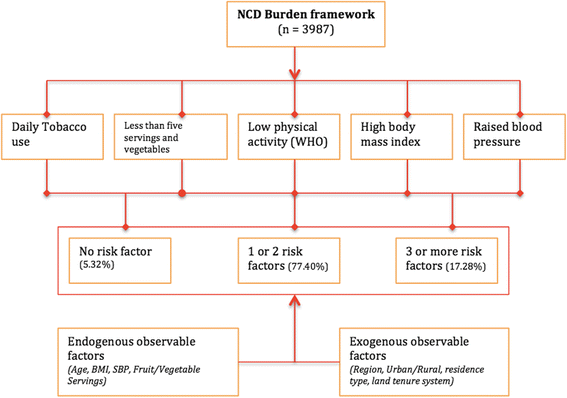Burden of cumulative risk factors associated with non-communicable diseases among adults in Uganda: evidence from a national baseline survey
- PMID: 27905949
- PMCID: PMC5133748
- DOI: 10.1186/s12939-016-0486-6
Burden of cumulative risk factors associated with non-communicable diseases among adults in Uganda: evidence from a national baseline survey
Abstract
Background: Modification of known risk factors has been the most tested strategy for dealing with non-communicable diseases (NCDs). The cumulative number of NCD risk factors exhibited by an individual depicts a disease burden. However, understanding the risk factors associated with increased NCD burden has been constrained by scarcity of nationally representative data, especially in the developing countries and not well explored in the developed countries as well.
Methods: Assessment of key risk factors for NCDs using population data drawn from 3987 participants in a nationally representative baseline survey in Uganda was made. Five key risk factors considered for the indicator variable included: high frequency of tobacco smoking, less than five servings of fruit and vegetables per day, low physical activity levels, high body mass index and raised blood pressure. We developed a composite indicator dependent variable with counts of number of risk factors associated with NCDs per participant. A statistical modeling framework was developed and a multinomial logistic regression model was fitted. The endogenous and exogenous predictors of NCD cumulative risk factors were assessed.
Results: A novel model framework for cumulative number of NCD risk factors was developed. Most respondents, 38 · 6% exhibited one or two NCD risk factors each. Of the total sample, 56 · 4% had at least two risk factors whereas only 5.3% showed no risk factor at all. Body mass index, systolic blood pressure, diastolic blood pressure, consumption of fruit and vegetables, age, region, residence, type of residence and land tenure system were statistically significant predictors of number of NCD risk factors (p < 0 · 05). With exception to diastolic blood pressure, increase in age, body mass index, systolic blood pressure and reduction in daily fruit and vegetable servings were found to significantly increase the relative risks of exhibiting cumulative NCD risk factors. Compared to the urban residence status, the relative risk of living in a rural area significantly increased the risk of having 1 or 2 risk factors by a multiple of 1.55.
Conclusions: The non-communicable disease burden is on the increase, with more participants reporting to have at least two risk factors. Our findings imply that, besides endogenous factors, exogenous factors such as region, residence status, land tenure system and behavioral characteristics have significant causal effects on the cumulative NCD risk factors. Subsequently, while developing interventions to combat cumulative risk factors of NCDs, the Ministry of Health needs to employ a more holistic approach to facilitate equitable health and sensitization across age, residence and regional divide.
Keywords: Cumulative risk factors; Disease burden; Non-communicable diseases; Prevalence; Uganda.
Figures
Similar articles
-
The burden of non-communicable diseases and their related risk factors in the country of Georgia, 2015.BMC Public Health. 2019 May 10;19(Suppl 3):479. doi: 10.1186/s12889-019-6785-2. BMC Public Health. 2019. PMID: 32326912 Free PMC article.
-
The prevalence and distribution of non-communicable diseases and their risk factors in Kasese district, Uganda.Cardiovasc J Afr. 2013 Apr;24(3):52-7. doi: 10.5830/CVJA-2012-081. Cardiovasc J Afr. 2013. PMID: 23736126 Free PMC article.
-
Noncommunicable disease risk factors among older adults aged 60-69 years in Nepal: findings from the STEPS survey 2013.J Hum Hypertens. 2019 Aug;33(8):602-612. doi: 10.1038/s41371-019-0161-7. Epub 2019 Jan 15. J Hum Hypertens. 2019. PMID: 30647463
-
Non-communicable diseases, food and nutrition in Vietnam from 1975 to 2015: the burden and national response.Asia Pac J Clin Nutr. 2018;27(1):19-28. doi: 10.6133/apjcn.032017.13. Asia Pac J Clin Nutr. 2018. PMID: 29222878 Review.
-
Disparities of obesity and non-communicable disease burden between the Tibetan Plateau and developed megacities in China.Front Public Health. 2023 Jan 10;10:1070918. doi: 10.3389/fpubh.2022.1070918. eCollection 2022. Front Public Health. 2023. PMID: 36703857 Free PMC article. Review.
Cited by
-
Community health workers' involvement in the prevention and control of non-communicable diseases in Wakiso District, Uganda.Global Health. 2021 Jan 7;17(1):7. doi: 10.1186/s12992-020-00653-5. Global Health. 2021. PMID: 33413500 Free PMC article.
-
Reasons for poor blood pressure control in Eastern Sub-Saharan Africa: looking into 4P's (primary care, professional, patient, and public health policy) for improving blood pressure control: a scoping review.BMC Cardiovasc Disord. 2021 Mar 4;21(1):123. doi: 10.1186/s12872-021-01934-6. BMC Cardiovasc Disord. 2021. PMID: 33663387 Free PMC article.
-
Prevalence and socio-demographic correlates of tobacco and alcohol use in four sub-Saharan African countries: a cross-sectional study of middle-aged adults.BMC Public Health. 2021 Jun 12;21(1):1126. doi: 10.1186/s12889-021-11084-1. BMC Public Health. 2021. PMID: 34118914 Free PMC article.
-
Individual and household level factors associated with presence of multiple non-communicable disease risk factors in Kenyan adults.BMC Public Health. 2018 Nov 7;18(Suppl 3):1220. doi: 10.1186/s12889-018-6055-8. BMC Public Health. 2018. PMID: 30400905 Free PMC article.
-
Assessment of Risk Factors of Noncommunicable Diseases among Semiurban Population of Kavre District, Nepal.J Environ Public Health. 2021 Jun 7;2021:5584561. doi: 10.1155/2021/5584561. eCollection 2021. J Environ Public Health. 2021. PMID: 34211559 Free PMC article.
References
-
- World Health Organization . STEPS instruments for NCD risk factors (core and expanded version 1.4): the WHO STEPwise approach to Surveillance of noncommunicable diseases (STEPS) 2001.
-
- Cureau FV, Duarte P, Santos DL, Reichert FF. Clustering of risk factors for non-communicable diseases in Brazilian adolescents: Prevalence and correlates. J Phys Act Health. 2014;11. - PubMed
MeSH terms
LinkOut - more resources
Full Text Sources
Other Literature Sources


